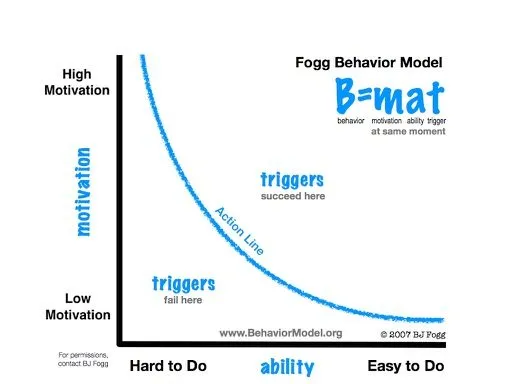
picture by B.J. Fogg; Behaviour Model
I would like to thank you.
A few days ago @detlev, an experienced Hive member published an article of mine and the response from you was fantastic. I am still speechless.
Together with @detlev, I will shed more light on the topic of NFTs from a gamification perspective.
But now I thought I'd go into more detail about the specifics of behavioural psychology if that seems to interest some of you here. Of course, I'm looking forward to the exchange as well!!!
Ok, #HIVE Family,
related to some answers and comments, some here are interested in reaching people in communities, and the like.
Two of the big categories for this are #Nudge and #Gamification. Whoever of you here is interested in community-driven projects, one of the two approaches might be something for you.
Let me explain:
Even a few years after Richard H. Thaler was awarded the Nobel Prize for his work on behavioral economics, there is no end to the subject. The topic is still en vogue. Behavioral economics as the lifeline for stumbling companies, projects, or platforms? Or as the competitive advantage for the big players? Again and again, the topic lands in my social media stream, in my mailbox or in Messenger: Gamification vs. nudge.
Since the Nobel Prize for Richard Thaler, you can find many posts and comments equating #Nudge with #Gamification or describing them as completely interchangeable. This hurts my soul, of course. 😭 Buzz word bingo everywhere. So here's an introduction: What are gamification and nudge and what are they actually good for? Now does this example belong to one or the other? What's the difference? Which is better?
Both Gamification and Nudge can - up to a certain point - work together, but come from ➡️ different ⬅️ directions. I hope that this brief description helps to better understand both topics:
Both approaches have one thing in common: they pay attention to human behavior. However, both go different ways and to a certain degree, they can be used together. Why only to a certain degree? I will come back to this at the end.
The model
The model
To be able to explain the difference well, I make use of BJ Fogg's behavioral model.
Brian J. Fogg is a well-known behavioral psychologist at Stanford University and also director of the Stanford Persuasive Technology Lab.
Put simply, Fogg's behavioral model states that the confluence of three elements leads to behavior in humans. The three elements are:

- Trigger
- Motivation
- Ability
In the quick version (warning, spoiler alert) - whether it's Gamification or Nudge - a blanket statement can be made that a Nudge tends to focus on the X-axis (Ability), while Gamification would start at the Y-axis (Motivation).
Explanation
If a trigger (I see a friend on the other side of the street) meets the motivation (I would like to talk to a said friend) and the ability (I can cross the street because there are no cars coming) then the behavior of crossing the street occurs.
If my motivation would be low, but it would be very easy to cross the street quickly, say hello and go my way again, then the street crossing behavior would probably occur as well. But if my motivation is low and there seems to be no gap between the cars on the road in sight, then I would probably rather go my way and the meeting would not take place.
However, if my motivation is very high, I patiently look for a gap in the traffic or even go back a hundred meters to cross the street at a traffic light to be able to greet the friend.
So the lower the #motivation for action, the greater should be the ability to perform it. Or rather, the easier the action should be to accomplish.
Deployment
So when it comes to people's actions, you can either increase their motivation (Y) to do something or you can make it easier (X) to perform the desired behavior. On the motivation side, you can now distinguish again whether you want to motivate extrinsically or intrinsically. But I won't go into that in more depth in this post.That is enough for a separate article. 😉

Richard Thaler
A nudge is now a
...small, imperceptible nudge that steers the individual in the right direction.
(- Richard H. Thaler, Book Nudge, page 2)
All nudges that I have encountered so far achieve this imperceptible nudge by making it so easy for the person to perform the desired action that anything else would require a significantly self-motivated action. Thus, the probability of following the nudge increases many times over. In addition, this nudge usually comes unnoticed and a conscious decision is missing.
A good example of this is the cross already made when asked whether one would like to become an organ donor. While in Germany one must actively consent to be an organ donor, in most European countries one must actively object. If one considers the inertia of humans, then everyone can imagine, what that means. This is also called decision architecture.
Result
In practice, it means that the presentation of possible decisions is changed in such a way that the addressed target group takes the path of 'least resistance' and this leads to the desired behavior.
Gamification focuses on increasing the motivation of the target group to deal with the topic more deeply and to make a decision based on this.
This makes it clear what the difference is between gamification and nudges: nudge aims at an already predetermined goal, while gamification focuses on a conscious decision of the target group. If you know the optimal result, you achieve your goal with the nudge, including a, from my personal point of view, slightly bland aftertaste of manipulation or paternalism. If the result is rather unknown and you want to rely on the knowledge of the target group to move forward, then gamification should be used.
Back to the beginning
At the beginning of this article, I mentioned that both approaches can be used together to a certain degree. Why only to a certain degree? This is due to the contrasting characteristics of Gamification and Nudge.
I also made a deeper video about this very thing, where we contrast the two topics. But it is in German:
Gamification should, for sustainable functioning, primarily focus on intrinsic motivation. In addition, it can also refer to extrinsic and intrinsic rewards, both of which belong to extrinsic motivation. Extrinsic motivation, however, is inferior to intrinsic motivation in terms of effectiveness and long-term/sustainable use. Without going into detail here (you are welcome to contact me for questions or comments on this), one can generally agree that intrinsic motivation comes primarily from personal progress. However, we are talking about the progress that results from a challenge and not from simply checking off to-do lists. In other words, in a gamified application, engagement comes mainly from a challenge, learning, passing, and a now increased challenge. We call this the Path to Mastery.
A nudge, as we know, is about making it easier for the person to do something. This is in contrast to the Path to Mastery. Both can appear together (after all, we experience challenge and relaxation together in the game --> an intrinsically motivated activity) but only up to a certain degree. If the weighting of the nudge gets out of hand, then an activity quickly becomes boring and you no longer have a chance to score in the area of existing motivation. Finding the balance between gamification and nudge is often a balancing act. But it can be worth it.
Be very happy to let me know what you think. Do you want more on the subject? Or applied to and considered in a very specific context?
I am looking forward to it!
Be very happy to let me know what you think. Do you want more on the subject? Or applied to and considered in a very specific context?
I am looking forward to it!
